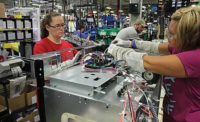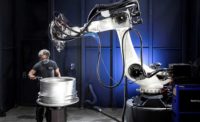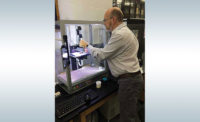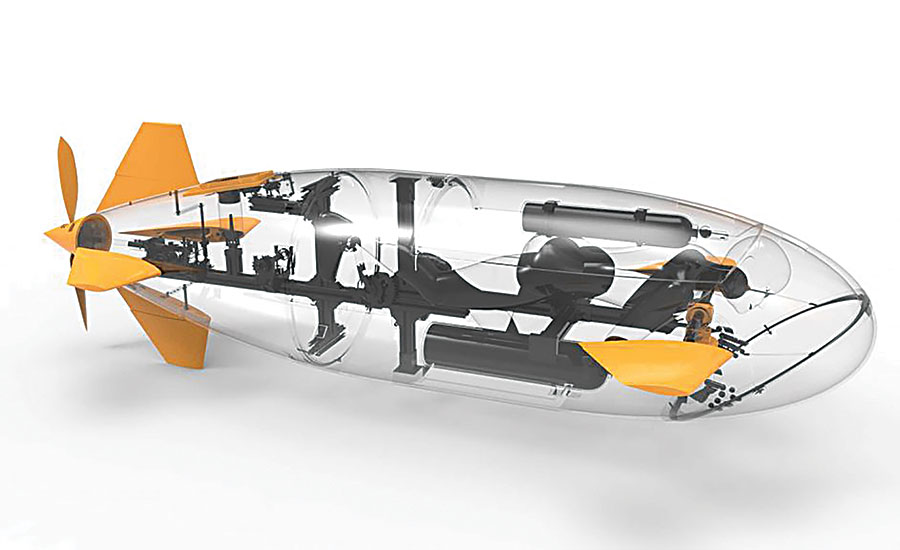New Plastics for 3D Printing
Engineers have more material options available than ever

Blades, fins, steering components and other parts of this miniature submarine were printed with acrylonitrile-butadiene-styrene. Photo courtesy Stratasys Ltd.

This high-strength material withstands high-temperature 3D printing and is ideal for medical device applications. Photo courtesy Taulman3D

A polyamide-based material reinforced with carbon fibers was used to produce the structure of this ski boot. Photo courtesy CRP Technology

The Atlas V rocket, built by United Launch Alliance, is the first vehicle to adopt 3D printing for serial production of thermoplastic components. Photo courtesy Stratasys Ltd.




What do rockets, ski boots and submarines have in common? They can all be assembled with plastic-printed components.
Brackets, nozzles and other parts used in the Atlas V rocket were recently 3D printed in polyetherimide. The ski boot was created with a polyamide-based material reinforced with carbon fibers. Blades, fins, steering components and other parts of the miniature sub were printed with acrylonitrile-butadiene-styrene (ABS).
Although metal is making new inroads, due to its greater strength and resistance, plastic is still the king of additive manufacturing applications.
When 3D printing with plastics first hit the market, ABS, nylon and polylactic acid (PLA) were the only materials available. They remain the most popular and easiest to work with.
However, engineers today have a wide variety of options to choose from, including polycarbonate, polyetheretherketone (PEEK), polyethylene terephthalate and thermoplastic polyurethane. There’s even a funky material called stainless steel PLA that prints like plastic, but polishes like metal.
The range of plastics that can be used in additive manufacturing is huge compared to other types of materials. They differ in transparency, color, rigidity, biocompatibility, hardness, fire retardancy, smoke emissions and other properties.
“While we constantly hear about breakthrough material developments in metal or biomaterials, thermoplastics still represent the solution with the best price-to-performance ratio,” says David Miklas, CEO of be3D, an industrial 3D printer manufacturer that’s a division of Y Soft Co. “Today, companies can use thermoplastics for many purposes, from prototyping to small-batch production.”
“Most 3D-printed plastics are replacements for traditionally manufactured plastics, because of design freedom, reduced materials wastage, mass customization and dispersed manufacturing,” adds Rachel Gordon, technology analyst at IDTechEx. “The 3D printing technologies and the materials they can print are intrinsically linked.
“There are more thermoplastic filaments available for 3D printing now than a few years ago,” explains Gordon. “There’s also a wider range of technologies available.
“The trend is toward a wider variety of properties,” says Gordon. “We’ve seen more rigid and more flexible materials, especially elastomers. We’ve also seen more and more fillers for electrical conductivity, magnetism, strength, toughness or unusual textures.
“But, the range is still very limited,” Gordon points out. “While there are 12,000 industrial thermoplastics, less than 20 can be bought as 3D printing filament.”
Engineers can use several different processes to print plastic parts. Popular options include fused deposition modeling (FDM) and selective laser sintering (SLS).
FDM makes it possible for components of almost any size to be produced, because there are no predetermined space requirements to pose any restrictions.
SLS uses a diode-pumped fiber optic laser that allows engineers to process higher melt-point materials. It is ideal for producing complex geometries that cannot be made by traditional manufacturing methods, such as ducting and air-handling components.
Cost Concerns
Unfortunately, many plastic materials are still expensive. Prices are slowly dropping, but the industry lacks a certification authority that would help correspond pricing with quality and accelerate development.
“Plastics have become more cost effective over the last few years, but it still trails behind the price point of commercial plastics,” says Chuck Alexander, director of product management at Stratasys Direct Manufacturing. “As the volume used increases, I suspect we’ll continue to see the price point come down.
“While the price per kilogram for additive thermoplastics may be higher, customers are only paying for what’s used for production,” notes Alexander. “This becomes especially important when considering high-performance thermoplastics like polyetherimide and polyetherketoneketone (PEKK). As a result, users may find that the cost of printing a part is cheaper than machining a large billet of these specialty materials.”
“The cost of printing plastics is more than the sum of the materials, and will continue to come down,” predicts Robert McKay, head of business development at Victrex, a leading producer of additive manufacturing materials. “For example, we are working with partners to optimize the machine, materials, process and part design to improve printing speeds, increase yields and improve powder recycling rates when laser printing with polyaryletherketone (PAEK).”
Victrex has been instrumental in the formation of an industry consortium to address this specific issue. A key objective is the improvement of the recycle rate for powders used in laser sintering. According to McKay, this would significantly reduce polymer wastage and reduce costs. The project will also address unpredictability of inter-layer adhesion and parts surface finish in filament-based printing.
“When a solution is found, it should dramatically lower the total cost of printing” claims McKay. “We can expect to see grades optimized for printing rather than for injection molding or extrusion.”
That’s good news for engineers looking for a way to justify investment in additive manufacturing equipment. It should also lead to more innovative materials.
“Filled plastics have been popular in recent years, particularly in laser sintered plastics,” Alexander points out. “Glass-filled nylon has been a standard for quite some time, but we have also introduced carbon-fiber filled nylon 12, as well as a mineral-fiber filled nylon 12.
“What we see emerging now are more production-grade plastics like PEKK and polyetherimide that provide added strength, heat resistance and chemical resistance,” says Alexander. “There is also an increasing desire to see some commercially available plastics like polypropylene, high- and low-density polyethylene, and polyethylene terephthalate (PET).”
“[Engineers] want the same materials, with the same performance, that are used in plastic-injection molding and other more mature manufacturing methods,” notes McKay. “[They] want to be able to start production in 3D printing with PEEK, and then seamlessly transition to injection molding, or to take a part that was injection-molded and customize it with 3D printing.
“Continuing to close the gap in performance is an ongoing objective,” adds McKay. “Also, the addition of carbon- and glass-filled composites is a priority.”
New Applications
According to the 2016 ASSEMBLY State of the Profession survey, additive manufacturing is most popular in the automotive, aerospace and medical device industries.
“The latest trends are about purposes, not just the plastics,” says Greg Paulsen, director of project engineering at Xometry Inc., a 3D-printing service company that works with manufacturers such as Boeing, Medtronic and Toyota. “We have seen additive manufacturing taken off its pedestal and treated more as another machine for plastic and metal fabrication.
“We have been seeing more and more end-use prototypes, one-offs and low-batch production using technologies and materials like SLS nylon and the multiple FDM thermoplastics,” adds Paulsen. “Even a couple of years ago, we would see mostly prototypes, so this is a great change.”
According to Paulsen, nylon is commonly used for automotive applications because of its durability and resistance to high temperatures. “Laser-sintered nylon by far has been the most popular thermoplastic for automotive,” he points out. “This is because of the ability to build in free-form and the watertight nature of the process. Other materials have a lot of promise, but permeability is a big issue.
“PEEK is very cool, but it has limited availability in the U.S. and tends to be pricey,” explains Paulsen. “From a tried-and-true industrial additive manufacturing approach, we have been pretty excited about acrylonitrile styrene acrylate for an ABS replacement, and Ultem 1010 and 9085 for highly heat-resistant applications. ABS-ESD7, which has static dissipative properties, fits a variety of applications, such as ducting, electromechanical housings and fixturing.”
Another new material that is ideal for automotive applications is PerFORM, a ceramic-filled composite resin from DSM Somos. “It combines the high accuracy and aesthetics associated with stereolithography with the growing demand for thermal and dimensional stability at elevated temperatures,” says Stratasys Direct Manufacturing’s Alexander. “It is a great solution for applications like automotive housings and components, electrical casings, wind tunnel models and even tooling.”
The aerospace industry is also pushing the envelope when it comes to developing new applications for printed polymer parts. Polyetherimide is a popular material used for many applications in that industry, because engineers can produce parts that meet the strict flame, smoke and toxicity requirements set by the FAA.
“The popularity of materials for these applications is largely driven by specific requirements,” notes Alexander. “The aerospace industry is most interested in flame-retardant options, so Ultem 1010 and 9085, as well as nylons like FR-106, are very popular.”
One of the newest thermoplastic materials that has attracted the attention of engineers at Boeing and other aerospace manufacturers is PEKK CF HT-23. “The material is a departure from typical laser sintering materials in that it is geared toward demanding, end-use product applications,” says Alexander. “PEKK is an advanced, high-temperature engineering polymer, featuring excellent mechanical properties, chemical resistance, thermal stability and flame
retardancy.”
In addition to the improved properties of the base polymer over the typical nylon properties, HT-23 is further enhanced by the addition of carbon fibers.
“While carbon-fiber composite nylons have been utilized in laser sintering for quite some time, the dry blended nature of these materials results in parts that have orthotropic properties,” explains Alexander. “HT-23’s particles feature encapsulated carbon fibers, which reduces the anisotropy of the resultant parts.”
More uniform material properties increase design flexibility for engineers. Therefore, part orientation during the laser sintering process will be less important for this new material than traditional carbon-fiber reinforced materials.
“The high strength and light weight of HT-23 makes it competitive against aluminum or carbon-fiber composite weave in some situations, making it an ideal candidate for aerospace applications, and high temperature and corrosive environments,” claims Alexander.
“In aerospace, customers want polymers that can survive in demanding environments, where [there often is] a broad range of temperatures and corrosive chemicals,” adds Victrex’s McKay. “They also want materials that are already proven in many years of service, such as PEEK-based solutions.”
Victrex is currently developing new grades of PAEK polymer based on chemical formulations that are specifically designed to work in additive manufacturing processes. Although used in some applications today, McKay says current PAEK materials were originally developed for use in injection molding or extrusion processes. The new grades are being targeted for aerospace and medical device applications.
Like automotive and aerospace, the medical industry has its own unique requirements for printed plastic parts. According to Dave Evans, CEO of Fictiv Inc., a hardware development platform for engineers, ABS is a popular material with medical device engineers.
“The medical industry tends to have material constraints for specific applications,” he points out. “We’ve seen medical device companies use additive manufacturing for fit checks and in the engineering validation test stage of development, and then use other processes to create medical-grade plastic parts for FDA approval.”
“Biocompatible materials are of high interest, [especially] ISO 10993 or USP Class VI compatible materials that can be sterilized,” adds Alexander. “These materials can be used for a wide array of medical applications, including custom and low-volume surgical components.”
Flexibility is also extremely important to medical device engineers. That’s why Voodoo Manufacturing, a 3D printing service company, recently began producing parts made from thermoplastic polyurethane (TPU), which has rubber-like elasticity
“It allows for the creation of objects that can withstand repeated stretching, movement and impact without wear or degradation,” says Jonathan Schwartz, co-founder and chief product officer at Voodoo Manufacturing. “TPU is also known for its high tensile strength, abrasion resistance, chemical resistance and recyclability, making it a popular material for thousands of medical applications, such as seals, plugs, hoses, and other flexible and functional parts.”
Another new product aimed at medical device applications is a high-strength, polyethylene terephthalate glycol-modified material, dubbed guidel!ne, that withstands high-temperature 3D printing. According to Taulman3D, guidel!ne complies with ISO 10993. A key feature is its ability to easily print small, hollow tubes. Its high print temperature also allows guidel!ne to be used as a zero-gap support material for medical-grade nylon parts.
Looking for a reprint of this article?
From high-res PDFs to custom plaques, order your copy today!










